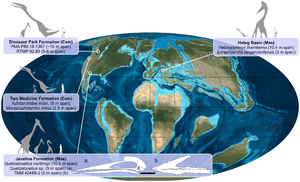Hațeg Island
.jpg)
Hațeg Island was a large offshore island in the Tethys Sea which existed during the late Cretaceous period, probably from the Cenomanian to the Maastrichtian ages.[1] It was situated in an area corresponding to the region around modern-day Hațeg, Hunedoara County, Romania.[2] Maastrichtian fossils of small-sized dinosaurs have been found in the island's rocks.[3]
It was formed mainly by tectonic uplift during the early Alpine orogeny, caused by the Adriatic Plate's northwest movement across the Piemont-Liguria Ocean towards the end of the Cretaceous. There is no real present-day analog, but overall, the island of Hainan (off the coast of China) is perhaps closest as regards climate, geology and topography, though still not a particularly good match. The vegetation, for example, was of course entirely distinct from today, as was the fauna.

The Hungarian paleontologist Franz Nopcsa theorized that "limited resources" found on the island commonly have an effect of "reducing the size of animals" over the generations, producing a localized form of dwarfism. Nopcsa's theory of insular dwarfism — also known as the island rule — is today widely accepted.
Geography
While a variety of estimates regarding the prehistoric island's size have been given over the years, the most reliable estimate places it at roughly 80,000 square kilometers during the Maastrichtian, or about the size of the modern island of Hispaniola. It was positioned just within the equatorial belt, at about 27°N latitude.[1]
Haţeg Island was probably located at least 200 kilometres (120 mi) from the nearest land mass. To the northwest was an island corresponding to the Bohemian Massif, to the southeast was an island corresponding to the Balkan–Rhodope Massif (including the modern Rhodope Mountains region), and to the west was a large island corresponding to part of the modern Iberian land mass. The closest continental land mass were portions of the Austro-Alpine region to the west and the Adriatic region to the south.[1]
Haţeg Island itself was surrounded primarily by a deep marine basin, unlike some of the surrounding islands and land masses which were surrounded by shallow seas.[1]
Climate and ecology
During the Maastrichtian, the climate of Haţeg Island was sub-tropical, with an average temperature of 20-25 degrees Celsius.[1] The island experience marked rainy and dry seasons, but despite this the plant life on the island was mainly tropical in nature. Carbon isotopes indicate "dry woodland" conditions. This seeming contradiction between the seasonally dry climate and tropical plant species can be explained by the fact that tropical plants can thrive in a seasonally monsoonal environment today as long as they have access to sufficient amounts of water year-round, and the Haţeg environment seems to have been dominated by braided rivers and lakes. Early rock layers are dominated by volcanic deposits, but these are absent in higher layers, indicating that volcanic activity dropped off during this time.[1]
Paleofauna

About nine species of dinosaurs, and one species of pterosaur are thought to have been indigenous to the island. Most of these animals were smaller versions of mainland megafauna, which became smaller due to island dwarfism, although this is certainly not the case for Hatzegopteryx which, being one of the biggest pterosaurs ever, is an example of island gigantism. Among these animals are included:
- Theriosuchus sympiestodon, an atoposaurid
- Hatzegopteryx thambema, an azhdarchid
- Rhabdodon priscus, a rhabdodontid
- Zalmoxes robustus, a rhabdodontid
- Telmatosaurus transylvanicus, a hadrosaur
- Struthiosaurus transylvanicus, a struthiosaurine nodosaur
- Magyarosaurus dacus, a titanosaur (either a saltasaurid or a nemegtosaurid)
- Paludititan nalatzensis, a titanosaur
- Elopteryx nopcsai, an elopterygine troodont
- "Megalosaurus hungaricus", an indeterminate theropod
- Balaur bondoc, a eumaniraptoran
- Bradycneme draculae, an alvarezsaurid
- Eurazhdarcho langendorfensis, an azhdarchid
- A new recently found species of Azhdarchid is also found, but has no name yet.
See also
References
- 1 2 3 4 5 6 Benton, M.J., Csiki, Z., Grigorescu, D., Redelstorff, R., Sander, P.M., Stein, K., and Weishampel, D.B. (2010). "Dinosaurs and the island rule: The dwarfed dinosaurs from Haţeg Island." Palaeogeography, Palaeoclimatology, Palaeoecology, 293(3-4): 438–454.
- ↑ Csikia, Z.; M. J. Bentonb (2010). "An island of dwarfs — Reconstructing the Late Cretaceous Hațeg palaeoecosystem". Palaeogeography, Palaeoclimatology, Palaeoecology. 293 (3–4): 265–270. doi:10.1016/j.palaeo.2010.05.032.
- ↑ Grigorescu, D. (2005). "Rediscovery of a 'forgotten land': The last three decades of research on the dinosaur-bearing deposits from the Hațeg Basin". Acta Palaeontologica Romaniae. 5: 191–204.
External links
| Wikimedia Commons has media related to Hațeg Island. |